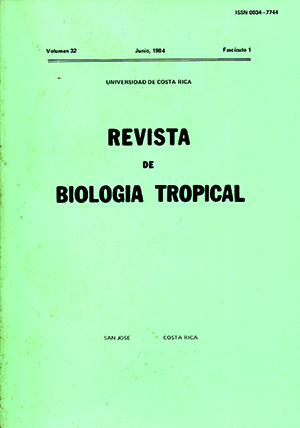Abstract
A biological study of a tropical chiton, Chiton stockesii, including aspects of its distribution, density, reproduction and biometry, was carried out at Punta Pochote, Bahía Ballena, Costa Rica, from August 1981 to July 1912. C. stockessi showed an aggregate-type distribution with a relative density of 0.2 ind./m2, 0.5 ¡nd./m2 and 6.3 ind./m2. In the upper, middle and lower littoral zones, respectively. The calculated correlation coefficients among all the measured variables were significant (P ≤ 0.01). It was not possible to determine sexual dimorphism (P ≤ 0.01) with respect to total length, height and weight. The lowest values for the coefficient of variation corresponded to the first two of these three variables (13.99% and 12.49%, respectively). The ratio of males to females was 1.54: 1, there was no evidence of hermaphroditism. The correlation between gonadal index and gonadal stage showed a similar seasonal variation (P ≤ 0.05). The periods of greatest gametogenesis and accumulation of mature gametes were from August-September 1981, and April-May 1982. The spawning seasons were between September-October 1981, November- February 1982 and June-July 1982. All of these periods were characterized by a decrease in the weight and length of the gonads.References
Arey, L.B., & W. J. Crozier. 1919. The sensory response of chitons. J. Exp. Zool., 29: 1 57-260.
Barbawell, E. B. 1954. The biology of the genus Mopalia in San Francisco Bay. M.A. Thesis, University of California, Berkeley.
Boyden, P. R. 1977. The physiology and behavior of chitons (Mollusca: Polyplacophora). Decanogr. Mar. Biol. Ann. Rev., 15: 461-509.
Brewin, B.J. 1942. The breeding habits of Crytoconchus porosus (Burrow). Trans. Roy. Soc. N.Z., 72: 186-191.
Cowden, R.R. 1961. A cytochemical investigation of oogenesis and development to the swimming larval stage in the chiton, Chiton tuberculatus L. Biol Bull., 120: 313-325.
Crozier, W.J. 1918. Growth of Chiton tuberculatus in different environments. Proc. Nat. Acad. Sci., 4: 325-328.
Crozier, W. J. 1920. Sex correlated coloration in Chiton tuberculatus. Amer. Nat., 54: 84-88.
Crozier, W.J. 1921. "Homing" behavior in chiton. Amer. Nat., 55: 276-281.
Dell, R.K. 1962. Stages in the development of viviparity in the Amphineura. Nature, 195: 512-513.
Elliot. J. M., & H. Décamps. 1973. Guide pour l'analyse statisque des échantillons d'invertebrés benthiques. An. Limnolo, 9: 79-120. Fisher, R. A. 1930. The genetica1 theory of natural selection. Dover Publications, Inc. New York, 291 p.
Glynn, P. 1970. On the ecology of Caribbean chitons Acanthopleura granulata Gmelin and Chiton tuberculatus Linné: Density, mortality, feeding, reproduction and growth. Smithsonian Contrib. Zool., 66: 1-21.
Giese, A.C., J.S. Tucker, & R.R. Boolootian. 1959. Annual reproductive cycles of the chitons Xathafina tunicata and Mopalia hindsii. Biol. Bull., 117: 81-88.
Giese, A.C., & J.S. Pearse. 1974. Reproduction of marine invertebrates. Academic Press. New York. 546 p.
Himmelman, J.H. 1978. Reproductive cycle of Xatharina tunciata Wood. and its controlling factors. J. Exp. Mar. Biol. Ecol., 31: 24-41.
Himmelman, J. H. 1980. Reproductive cycle parteros in the chiton genus Mopalia (Polyplacophora). Nautilus, 94: 39-49.
Keen, M.A. 1971. Sea shells-Tropical West America. Stanford Univ. Press. 1062 p.
Leigh, E.G. 1970. $ex-ratio and differential mortality between the sexes. Amer. Nat., 104: 205-210.
Lewis, J.B. 1960. The fauna of rocky shores of Barbados, West Indies. Can. J. Zool., 38:391-435.
Murti, K. G., & R. Nagabhushanam. 1968. Observations on the spawning and reproductive cycle of Chiton granoradiatus Leloup. Broteria (Natural Science series), 37: 223-233.
Nagabhushanam, R., & U.D. Desphande. 1982. Reproductive cycle of the Chiton iatricus and environmental control of its gonad growth. Mar. Biol., 67: 9-13.
Nimitz, M.A., & A. C. Giese. 1964; Histochemical changes correlated with reproductive activity and nutrition in the chiton Katharina tunicata. Quart. J. Micros. Sci, 105: 481-495.
Pearse, J.S. 1968. Reproductive periodicities of the marine animals of tropical Middle East waters. Office of the Naval Research Report, Contract Number NG 2558-5022 (NR 104-889). 71 p.
Ricketts, E.F., & J. Calvin. 1952. Between Pacific Tides. Stanford Univ. Press. 502 p.
Sokal. R.R., & F.J. Rohlf. 1979. Biometría. H. Blume Ediciones, España. 922 p.
Stephenson, A. 1934. The breeding of reef animals. Part. 2 : Invertebrates other than corals. Sci. Rep., Great Barrier Reef Expedition, 1928-29, 3: 247-272.
Thorpe, S. R. 1962. A Preliminary report on spawning and related phenomena in California chitons. The Veliger, 4: 202-210.
Watanabe, J. M., & L. R. Cox. 1975. Spawning behavior and larval development in Mopalia lignose and M. mucosa (Mollusca: Polyplacophora) in Central California. The Veliger (Suppl.) 18: 18-27.
Webber, H. H., & A. C. Giese. 1969. Reproductive cycles and gametogenesis in the black abalone Haliotis cracheroidii (Gastropoda: Prosobranchiata) Mar. Biol, 4: 152-159.
##plugins.facebook.comentarios##

This work is licensed under a Creative Commons Attribution 4.0 International License.
Copyright (c) 1984 Revista de Biología Tropical


